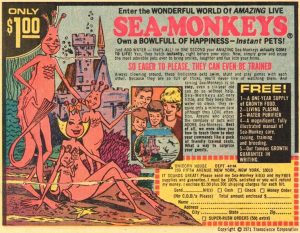Advertisements for mail-order novelty items were ubiquitous in comic books during, in particular, the 1950s and ’60s, and beyond. Magazines aimed at the youth market, too, often ran these ads. The hucksters who came up with this stuff preyed on the gullible by offering fantastical, amazing, stupendous—or so their ad copy claimed—toys, novelties, gag items, and other such flotsam. The products were designed, first, to remain affordable, in that the target customers were adolescents or teens, most often boys, who generally didn’t have a lot of money and even less judgement or self-control, and second, to relieve said kids of their allowances and hard-earned paper route money.
All of this miscellany was aggressively marketed with little regard for honesty and integrity; truth-in-advertising was most assuredly not a chapter in whichever sales manual was used by the people who pushed this paraphernalia.
Of the warehouses worth of cheap, over-hyped, and often fraudulently marketed product, Sea-Monkeys—Instant Pets!—is the unrivaled gold-medal winner in this category of merchandise. Harold von Braunhut was the inventor and master marketer who came up with Sea-Monkeys, inspired by a rival’s Ant Farm. Braunhut died in 2003 with close to 200 patents to his name.

On Zoom right now, we’re exploring some of those crazy, miraculous, impossibly astounding, and definitely not-as-advertised pop culture icons of a bygone era—monsters, spaceships, ghosts, dinosaurs, and more! To give credit where credit is due, most of the information we’ve gathered on this topic is contained in collector Kirk Demarais’ book Mail-Order Mysteries: Real Stuff from Old Comic-Book Ads.
Do join us on Zoom for all the fun!
This Afternoon’s MonSFFA e-Meeting on Zoom
Join by phone (voice only); in Montreal, call in toll-free: 1-438-809-7799. Find your out-of-town Zoom call-in number here: Call-In Numbers

